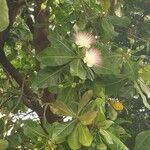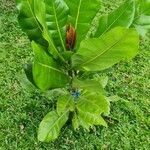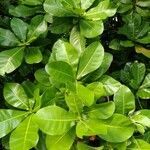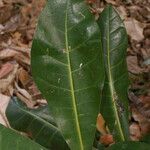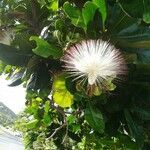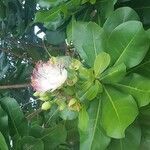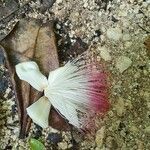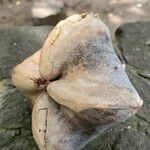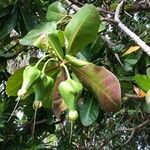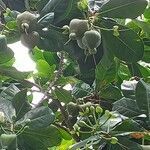Tree 7–30 m high, evergreen or deciduous, large trees may have thick buttresses. Bark fissured. Leaves: lamina obovate or obovate-oblong, (7–) 20–43 cm long, (4–) 7–20 cm wide, cuneate at base, entire margin, emarginate to mucronate at apex, coriaceous, glabrous; petiole ± absent or to 5 mm long. Racemes mostly terminal, mostly 3–7-flowered, sometimes up to 20 scented flowers; pedicels 4–8 cm long; bracts oval, 8–20 mm long; bracteoles triangular, c. 1.5–5 mm long. Bud 2–4 cm long. Calyx undivided, rupturing at anthesis into 2 unequal rounded or acuminate persistent lobes 3–4 cm long and 2–3 cm wide and tube 3 mm long. Petals 4, oblong-elliptic, 5.5–8.5 cm long, white or cream, sometimes with reddish or purplish margins. Stamens numerous, in 6 whorls, the innermost sterile; tube 1.5–6 mm long; filaments 8–15 cm long, white becoming pink, red or purplish towards apices; staminodia 2–3.5 cm long. Ovary 4-or 5-locular, 5–9 mm long; ovules 4 or 5 per locule; style 9–15 cm long. Fruit ± pyramidal, 4-angled (with 4 rounded basal lobes), smooth, 8.5–11 cm long and wide, green to brown, the apex tapering and crowned by calyx; pericarp spongy, fibrous. Seed 1, obloid, 4–5 cm long.
Trees 7-20 m tall. Branches stout; bark fissured. Leaves sessile, obovate to obovate-oblong, 20-40 × 10-20 cm, leathery, shiny, base cuneate, margin entire, apex obtuse or broadly rounded. Racemes mostly terminal, erect, 5-15 cm, 5-10(-20)-flowered; bracts ovate, 8-20 mm; bracteoles triangular, 1.5-5 mm. Pedicel 5-9 cm. Flower buds 2-4 cm in diam. Calyx undivided, rupturing at anthesis into 2 or 3 unequal, rounded or acuminate, persistent lobes 3-4 × 2-3 cm and a tube 3-5 mm. Petals 4, white, ovate or elliptic, 5-6 cm. Stamens in 6 whorls; tube 1.5-6 mm; filaments and style white, red-tipped; outer filaments 7-9 cm. Ovary 4-loculed, 5-9 mm; ovules 4 or 5 per locule; style 11-13 cm. Fruit dispersed by floating, broadly pyramidal, smooth, 9-11 cm, apex tapering and crowned by calyx; pericarp spongy, fibrous. Seed oblong, 4-5 cm. Fl. and fr. almost year-round. 2n = 26.
A small tree. It is 5-9 m tall. It can grow up to 25 m. It spreads to 3-5 m wide. The trunk is short and erect and branches occur from near the base. The leaves are 20 to 40 cm long and 10-15 cm wide and without individual leaf stalks. They are shiny light green, and larger near the tip than the base. The tip is rounded and somewhat pointed. The flowers are large and pink and white. They are 3-5 cm across. The fruit is sharply 4 and rarely 5-angled. The fruit are 12 cm across, woody and broad at one end. They contain one large seed.
